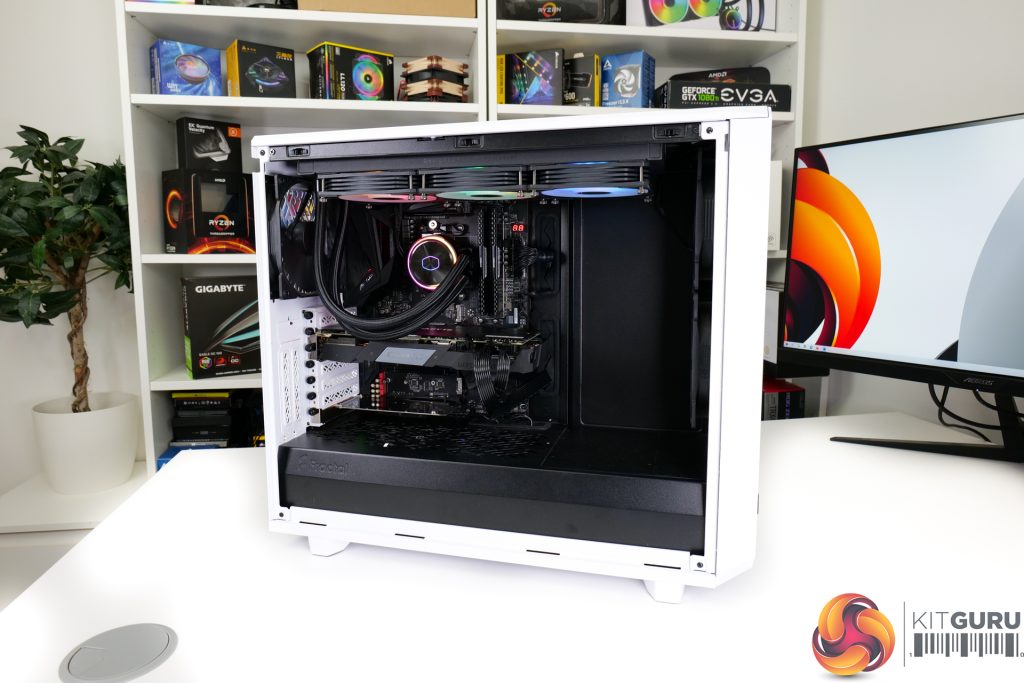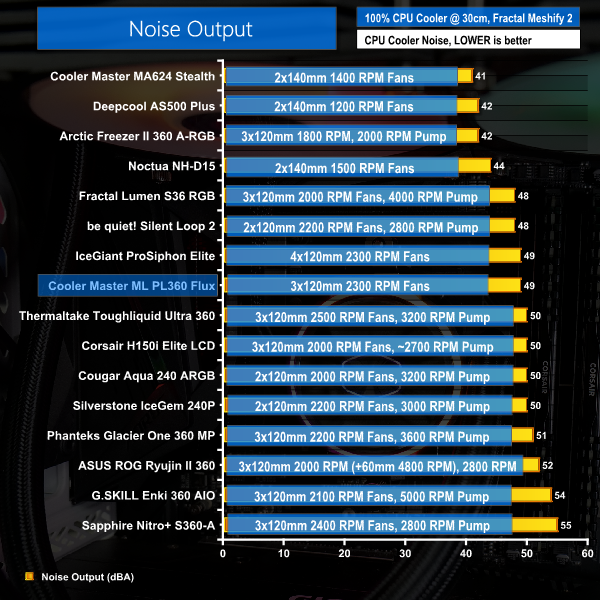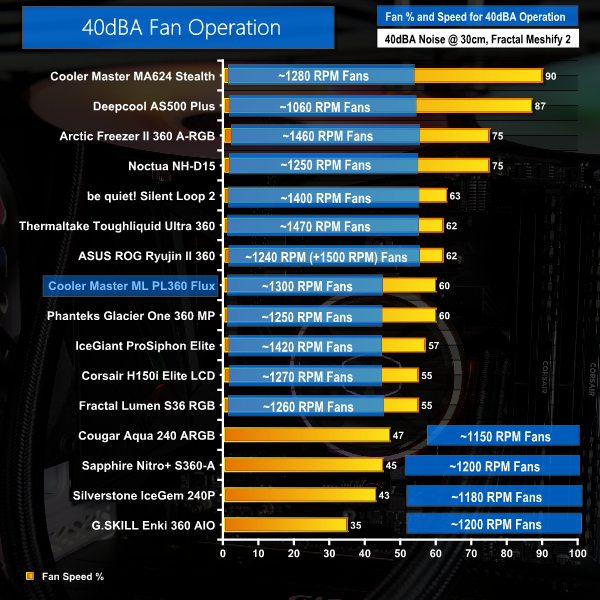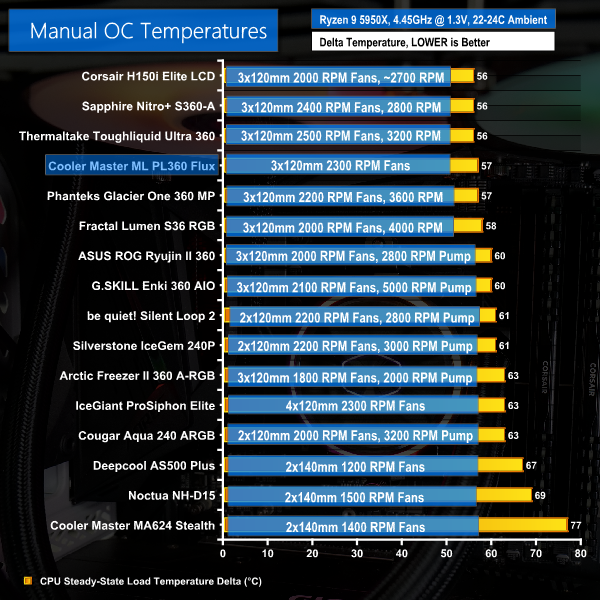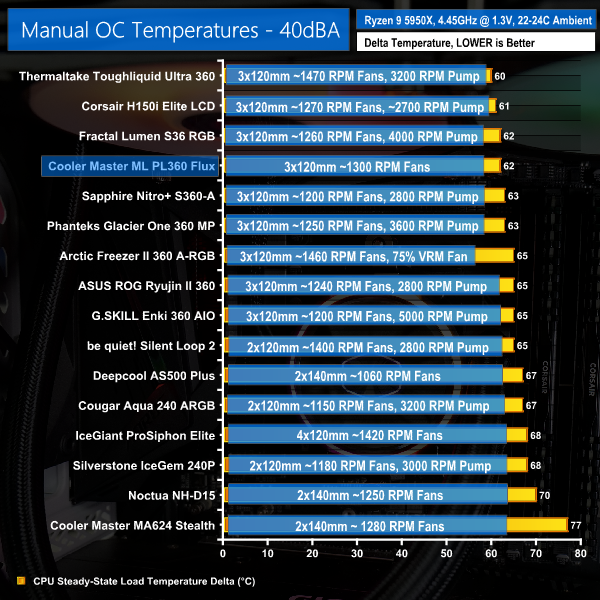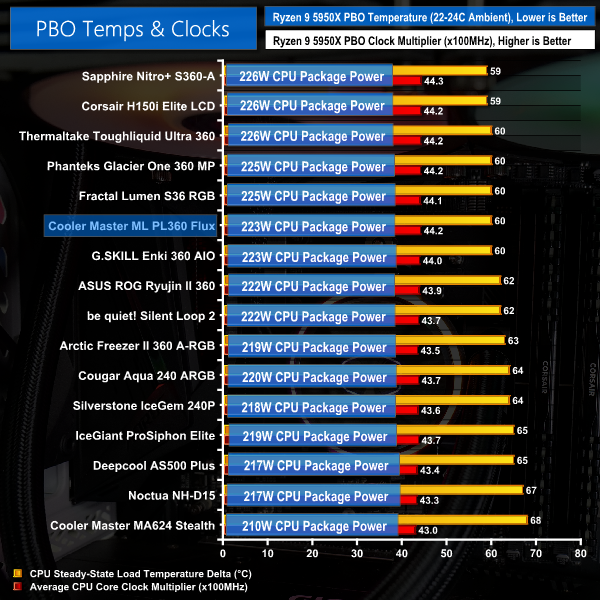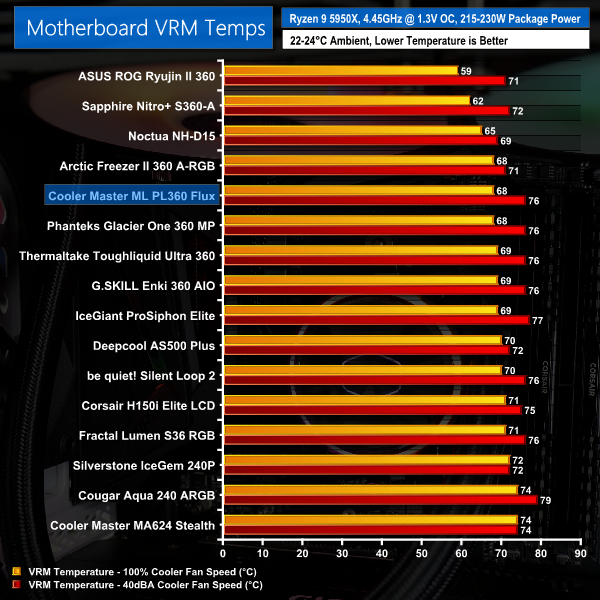Test System:
- Processor: AMD Ryzen 9 5950X
- Overclocked Settings: 4.45GHz all-core @ 1.312V (UEFI), Medium LLC – around 1.3V delivered
- Motherboard: Gigabyte B550 Aorus Master
- Memory: 32GB (2x16GB) Corsair Vengeance LPX 3600MHz 16-18-18-36 DDR4 @ 1.35V
- Graphics Card: Gigabyte RTX 2060 Super 0dB Mode
- Chassis: Fractal Design Meshify 2
- Chassis Fans: 2x140mm 1000 RPM Fractal Front Intake, 1x140mm 1000 RPM Fractal Rear Exhaust, plus additional 1x140mm 1000 RPM be quiet! Pure Wings 2 Roof Exhaust (for air cooler testing)
- Power Supply: Seasonic Prime TX-1000
- Operating System: Windows 10 Pro 64-bit
Testing Methodology:
- For testing, we use a 30-minute looped run of Cinebench R23 and record the steady-state CPU temperature at the end of the test. This ensures that the CPU has had ample time to warm up and reach steady state under all of the coolers.
- Ambient is maintained around 22-24 degrees Celsius. Where there is variation beyond this temperature range, we add in extra repeated tests to ensure consistency.
- We also test each cooler with at least two fresh installs (typically three) to mitigate the likelihood of a dodgy mount spoiling results.
Test Results:
Acoustics
Let’s start off with noise performance at 100% fan speed. This is important for getting an indication of where our performance expectations should lie based on noise output.
Cooler Master’s noise output numbers are actually quite reasonable and stay below 50dBA at full speed. This is largely thanks to the quality of the Flux series fans used, as the trio’s 2300 RPM maximum operating speed is undeniably high.
Of course, there is also the excellent fan speed control range all the way down to 0 RPM. So, this noise reading is simply a worst-case scenario. And even then, it really isn’t too bad.
In order to get the unit running at 40dBA, we had to reduce the fans down to 60% of their maximum speed when controlled through the motherboard UEFI. We did not change the pump speed.
This 60% duty cycle presented as around 1300 RPM when checked with the UEFI monitor and HWiNFO software.
Thermal Performance
Despite the highly tolerable maximum noise output, the Cooler Master MasterLiquid PL360 Flux doesn’t really look to give up too much in terms of performance.
With a 57C delta temperature in our test system, the PL360 Flux is only a smidgen behind the highest performance contenders in our chart. And all of those coolers were louder than the unit we are examining today.
Keeping well over 200W of overclocked Ryzen 9 5950X power below 80C with a sensible ambient temperature is a very positive result for Cooler Master’s new 360mm AIO.
Despite dropping down to 1300 RPM rotational speed on its three 120mm fans, the Cooler Master MasterLiquid PL360 Flux is able to maintain a promising performance rank in our chart.
Here, some of the notable Asetek competitors from the likes of Sapphire and Phanteks are beaten out. Though that Fractal Lumen S36 RGB presents itself as a formidable competitor, especially with its considerably lower £113 price point. Overall, Cooler Master does well in this 40dBA noise-locked performance test.
Clearly, there is also another 1000 RPM worth of speed available on tap if the cooling performance needs to be ramped up. And that point should not be underestimated when focusing solely on 40dBA thermal results.
PBO results are not quite as positive for the PL360 Flux as the manual overclocked tests are.
Here, Cooler Master’s unit roughly matches many of its 360mm AIO competitors. But there are some alternatives that handle a little more package power or deliver a little high operating frequency.
To be realistic, the margins here are tight and are close to the error levels. With that said, Cooler Master’s performance in this full fan speed test is not quite as promising as many of its other results that we have seen.
MOSFET temperatures are not great, as we would expect from an AIO liquid cooler without a pump-block mounted VRM cooling fan.
At full fan speed, the three 120mm blowers blast their way to a decent VRM temperature result. But the 40dBA noise-locked test shows a better picture for highlighting that incidental VRM cooling is not a strength for the MasterLiquid PL360 Flux. And that point extends to most other 360mm AIO that don’t have specific VRM fans – with Sapphire’s 3x120mm unit being an exception.
Be sure to check out our sponsors store EKWB here
 KitGuru KitGuru.net – Tech News | Hardware News | Hardware Reviews | IOS | Mobile | Gaming | Graphics Cards
KitGuru KitGuru.net – Tech News | Hardware News | Hardware Reviews | IOS | Mobile | Gaming | Graphics Cards


